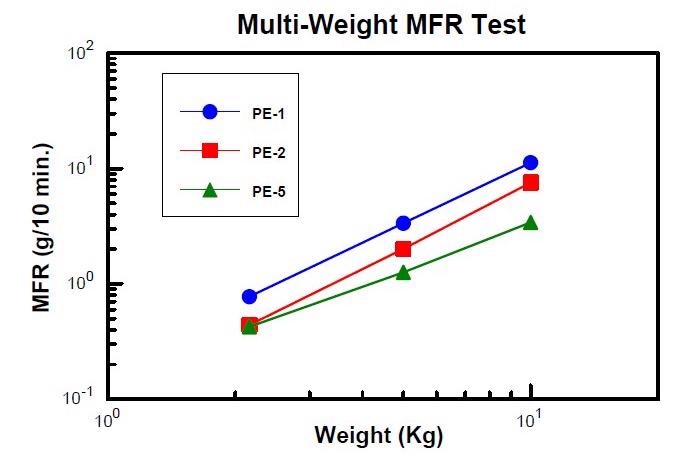The shear-thinning behavior of thermoplastic materials can be identified by carrying out a Flow Rate Ratio (FRR) test method in an extrusion plastometer (melt indexer).
Known as ‘Procedure D’ in ASTM D1238, this test method is a multi-weight assessment that was created to acquire two or three flow rates at two or three unique shear stresses or loads (usually with a 10:1 ratio) on one charge of material (at a consistent testing temperature).
An FRR parameter represents the results of this test, which is a dimensionless number and can be determined by dividing the melt mass flow rate (MFR) or melt volume flow rate (MVR) at the higher test load by the MFR or MVR at the lower test load, which is shown in the example below:

The MVR and MFR data from different loads can be presented as the flow curve of shear rate (utilizing the MVR and MFR data of the plastic melts) versus shear stress (utilizing the loads and barrel surface area information).

Image Credit: Dynisco
This graph can be employed to determine the polymer Power-law index parameter, which represents the polymer melt’s shear thinning behavior.
The data about the shear sensitivity of the melt flow of plastic melts and the shear thinning behavior are the manifestations of polymer melt elasticity and are highly sensitive to the molecular weight distribution (MWD) of the polymer.
Two polymers that are exactly the same (with different lot numbers), having the same MFR values at the standard weight (or same molecular weight and same zero shear viscosity), may exhibit entirely different melt flow behaviors at higher loads/shear stresses if the molecular structure differs. For example, there may be differences in melt elasticity, the broadness of MWD, branching structure, and more.

Image Credit: Dynisco
It is recommended that a flow rate ratio test is performed in a melt indexer with an automatic lift option as it can automatically and safely lift the weights as required. This is suggested because the weights involved in this test method are particularly heavy and can cause harm to the operator when routinely lifted.
A Method B mode must be used to perform the flow ratio test using two digital encoder flags at minimum. The automatic lift system will automatically lower the second weight onto the plunger between the first and second flag.
Once the flags have been processed, the instrument will calculate and present the data on the MFRs, MVRs (if chosen) and FRR.
Acknowledgments
Produced from materials originally authored by Azadeh Farahanchi from Dynisco.

This information has been sourced, reviewed and adapted from materials provided by Dynisco.
For more information on this source, please visit Dynisco.